Answer these simple questions and we will find you the BEST prices
Which type of solar quotes do you need?
It only takes 30 seconds
100% free with no obligation

Get Free quotes from insulation specialists near you

Save money by comparing quotes and choosing the most competitive offer

The service is 100% free and with no obligation
- GreenMatch
- Insulation
- Floor Insulation
- Concrete Floor Insulation
- Under Slab Insulation
Under Slab Insulation: Benefits, How to Install & Best Types

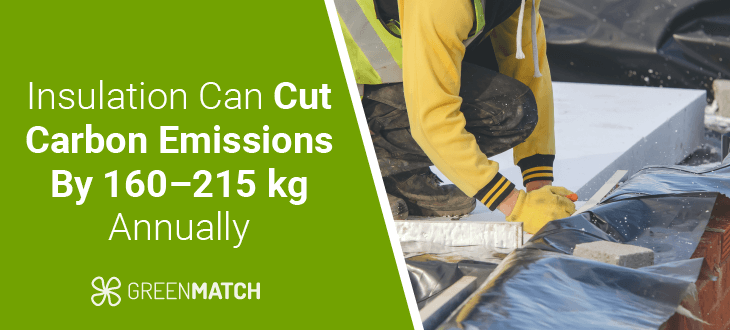
- Insulation can reduce annual carbon emissions by 160 kg in Great Britain and 215 kg in Northern Ireland.
- Under slab insulation offers significant benefits, including improved thermal comfort, reduced energy costs, and enhanced building efficiency.
- You may qualify for financial support through the Great British Insulation Scheme to improve your home's energy efficiency with insulation upgrades.
The UK market for insulation is growing, with the Energy Company Obligation (ECO) Scheme having installed millions of insulation measures in homes. This includes measures like under-slab insulation, which helps households reduce energy costs.
Echoing this market expansion, AMA Research stated that the UK insulation market has seen significant growth, with the value of building insulation products expected to rise to £1.5 billion by 2025. Ground-floor insulation, including under-slab, plays a crucial role in this growth.
Under slab insulation is a crucial component of energy-efficient, comfortable, and durable homes in the UK. This guide will detail how, by installing insulation under a concrete slab, homeowners can enjoy lower energy bills, better protection against moisture, and a more comfortable living environment while reducing their environmental footprint.
Ready to get started on your insulation project? Let us take care of everything for you! In less than 30 seconds, you can receive up to 3 free quotes from reliable, expert installers. Simply fill out the form below to start saving today!
- Describe your needs
- Get free quotes
- Choose the best offer
It only takes 30 seconds



What is under slab insulation
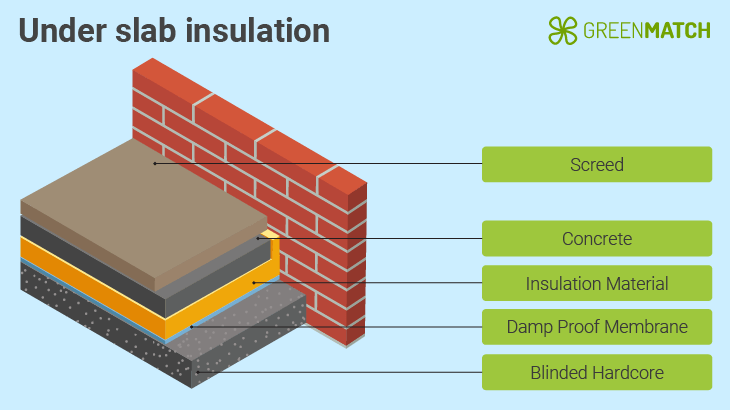
Under slab insulation is a layer of insulating material placed directly beneath a concrete floor slab. It is typically used in buildings to prevent heat transfer between the ground and the interior space above.
The insulation is installed before the concrete slab is poured, and it can be made from materials such as rigid foam boards or spray foam. This layer serves as a thermal barrier and is often part of the foundation construction, particularly in basements or ground floors.
Benefits of under slab insulation
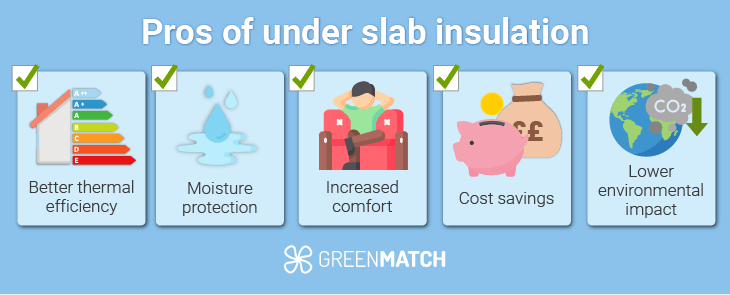
Under-slab insulation is essential in improving energy efficiency and comfort and protecting the structural integrity of UK homes. Insulation under a concrete floor slab offers several advantages, from enhanced thermal performance to moisture protection, making it a crucial aspect of modern building practices.
Enhanced thermal efficiency
One of the primary benefits of under concrete insulation is its ability to prevent heat loss. In the UK’s colder climate, insulation below slab helps retain warmth by stopping heat from escaping into the ground.
This is especially beneficial when underfloor heating is installed, as it ensures heat is directed into the living space rather than being lost. This not only reduces energy consumption but also lowers utility bills.
The Energy Savings Trust supported this by noting that heat savings can be achieved by insulation, which can reduce annual carbon emissions by 160 kg in Great Britain and 215 kg in Northern Ireland.
Moisture and damp protection
Another key benefit is moisture prevention. Insulation under concrete slabs acts as a barrier to ground moisture, protecting against dampness, mould, and potential structural issues. This is particularly important in the UK, where high humidity and wet weather can exacerbate moisture problems. Insulation under slab also helps maintain better indoor air quality by keeping dampness at bay.
Improved comfort
Installing under slab insulation makes the home more comfortable by increasing the floor temperature and reducing the cold feel often associated with concrete floors. This is especially important in ground-floor rooms, where thermal transfer from the earth can make the floor noticeably cold.
Additionally, insulating the floor maximises the effectiveness of underfloor heating systems, ensuring heat rises into the living space rather than being lost to the ground.
Reduced environmental impact
Insulating the floor contributes to improved energy efficiency, which supports the UK’s efforts to reduce carbon emissions. By improving your home’s thermal performance, under slab insulation helps meet building regulations and environmental targets for reducing energy consumption and emissions.
Long-term cost savings
Though under concrete slab insulation involves initial costs, it leads to substantial long-term savings. Reduced heat loss means lower energy bills, and it helps protect against moisture-related repairs, making it a cost-effective investment over time.
According to the Energy Saving Trust, insulating ground floors in UK homes can result in annual savings of £60 to £100 per year, on average, depending on the size and location of the property.
Considering these savings, make your home more energy-efficient and comfortable! Complete the form below to get up to 3 free tailored quotes and start reducing energy costs while boosting comfort. Get started now!
- Describe your needs
- Get free quotes
- Choose the best offer
It only takes 30 seconds



How to install insulation under concrete slab
Insulating concrete floors, particularly under a concrete floor slab, involves several key steps, from site preparation to concrete pouring. Here’s a step-by-step guide to installing under slab insulation that ensures the best results.
- Prepare the ground: Clear the site of debris, level the surface, and compact the soil. Proper ground preparation is crucial to create an even foundation for the insulation below the slab.
- Install a damp-proof membrane (DPM): Lay a damp-proof membrane on the compacted ground to protect against ground moisture. Ensure the membrane is sealed and overlaps at the joints, creating a continuous moisture barrier under the insulation under concrete slab.
- Lay the insulation boards: Install rigid insulation boards designed for ground floors. Place the boards in a continuous layer, making sure they fit tightly to prevent gaps and thermal bridging. Seal any joints with insulation tape for optimal performance of the insulation under the concrete floor slab.
- Add a separation layer (optional): An additional damp-proof membrane or separation layer may be placed over the insulation. This helps protect the insulation under the concrete slab from direct contact with wet concrete, which is particularly useful when installing underfloor heating.
- Install underfloor heating (optional): If you're incorporating underfloor heating, now is the time to install it. The insulation under concrete floor will enhance the system's efficiency by directing heat upwards.
- Pour the concrete slab: Pour the concrete over the under concrete slab insulation and level it evenly. This step creates the load-bearing surface above the insulation. Allow the concrete to fully cure before moving on to any flooring finishes.
- Finishing touches: After the concrete has cured, apply the desired flooring or finishes. The insulation under concrete slab will now provide improved thermal efficiency, moisture protection, and comfort for the building.
Best under concrete slab insulation
The material and its thickness are crucial when choosing the best floor insulation. We will examine the best materials, their R-values, and the ideal thickness for under-concrete insulation. Depending on the project, insulation thickness typically ranges between 25mm and 100mm, offering an optimal balance between cost and performance.
Polyisocyanurate (PIR) insulation boards
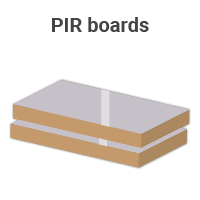
PIR boards are one of the most efficient materials for insulation under concrete floor slabs due to their high R-value and moisture resistance. PIR is lightweight, easy to install, and can achieve high thermal resistance with minimal thickness, making it an excellent choice for both residential and commercial applications in the UK.
- R-value: PIR boards offer an impressive R-value of approximately 4.5 to 6.0 per inch, depending on the product. This high R-value means that thinner PIR boards can provide excellent thermal insulation.
- Optimal thickness: For PIR insulation, a thickness of 50mm to 100mm is typically recommended. For high-performance insulation in areas with underfloor heating, 100mm of PIR is ideal, while 50mm may suffice in less demanding applications where thermal resistance requirements are lower.
Extruded Polystyrene (XPS)
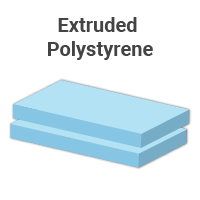
XPS insulation is known for its exceptional compressive strength and resistance to moisture, making it perfect for below slab insulation where the load-bearing capacity is important. Its closed-cell structure prevents water absorption, and it performs well in both thermal insulation and freeze-thaw cycles, which are common in the UK’s variable climate.
- R-value: XPS provides a reliable R-value of approximately 4.5 to 5.0 per inch, making it a highly effective thermal insulator for under concrete slabs.
- Optimal thickness: For optimal performance, XPS insulation usually requires a thickness of 80mm to 120mm. The thickness will depend on the load-bearing needs and the desired thermal efficiency. For residential use, 80mm is common, but 120mm is recommended for better compressive strength and insulation in areas like garages or industrial floors.
Expanded Polystyrene (EPS)
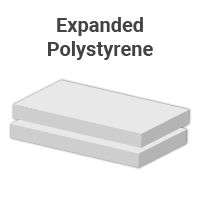
EPS insulation is a more cost-effective option compared to PIR and XPS, while still offering good thermal and moisture resistance. Although it has a lower compressive strength than XPS, EPS is suitable for insulation under concrete slabs in residential settings where load-bearing demands are lower.
- R-value: EPS has a slightly lower R-value of approximately 3.6 to 4.0 per inch, which means a thicker layer is generally required to achieve the same thermal performance as PIR or XPS.
- Optimal thickness: To meet UK building regulations for thermal efficiency, EPS insulation typically requires a thickness of 100mm to 150mm. While 100mm may be sufficient for most residential applications, 150mm is often used in colder regions or where higher insulation standards are required.
Key factors for choosing the right insulation material
When choosing under concrete slab insulation, it's important to consider factors that meet performance and environmental needs. In the UK's damp climate, certain materials offer better thermal efficiency, moisture resistance, and strength. Here are key points to keep in mind.
Thermal efficiency: The primary factor in choosing insulation is its R-value, which measures thermal resistance. Regarding floor insulation thickness, PIR boards offer the highest R-value per thickness, making them an excellent option for achieving significant thermal performance with thinner insulation.
XPS is also highly effective but requires a bit more thickness to deliver the same thermal benefits. EPS, while more affordable, typically needs a thicker application to reach comparable insulation levels.
Moisture resistance: In a damp climate like the UK, choosing insulation with good moisture resistance is critical. Both XPS and PIR have closed-cell structures that provide excellent moisture resistance, making them ideal for below-slab insulation. This feature helps prevent water ingress, protecting the integrity of the insulation over time, especially in areas prone to ground moisture.
Compressive strength: For spaces like garages or industrial areas that are subject to heavy loads, XPS is the best option due to its high compressive strength. It can withstand significant weight without losing its insulating properties. Meanwhile, PIR and EPS are more suited to residential applications with lower load-bearing requirements, where structural strength is less of a concern.
Under slab insulation cost
When selecting under-slab insulation, here’s a breakdown of each material, comparing them to the other options to help you make the best decision for your project. We created a table to help you compare the prices of the different materials for easier evaluation.
| Material | Cost per m² |
|---|---|
| PIR boards | £5 to £15 |
| XPS | £10 |
| EPS | £10 |
Along with the material costs, keep the following in mind:
- Labour: Hiring professionals to install insulation can increase costs significantly. Labour costs vary by region but may average around £250 per day depending on the job's complexity.
- Preparation: If your slab or floor needs repairs before insulation, such as fixing moisture problems, these costs should also be factored in.
- Ventilation adjustments: In some cases, mechanical ventilation or window vents might be required to prevent moisture buildup after installing insulation.
- Pest control: This is important, as insect infestations can be a concern. To prevent issues like termite infestations, it is recommended that insulation materials be treated with pesticides before installation.
Under floor insulation grants
The Great British Insulation Scheme (GBIS) is a government scheme designed to help households improve energy efficiency by offering financial support for insulation upgrades.
Launched in 2023, the scheme aims to assist around 300,000 households by providing free or heavily subsidised insulation, such as loft, cavity wall, or underfloor insulation. The goal is to help families save between £300 to £400 per year on energy bills.
Eligibility typically includes households in council tax bands A-D in England (A-E in Scotland and Wales) with an Energy Performance Certificate (EPC) rating of D or below. The scheme primarily benefits low-income households but has been extended to cover a broader range of homes with poor energy efficiency. The £1 billion GBIS scheme is scheduled to run until March 2026.
Is under slab insulation worth it?
An insulated floor is one of the most effective ways to improve your home's energy efficiency, comfort, and overall value. Here’s why investing in under slab insulation is worth considering:
- Significant energy savings: Insulating your concrete slab can significantly reduce heat loss through the ground, a major source of energy inefficiency in homes. In colder climates like the UK, this can lead to savings of up to £100 annually on energy bills, ultimately offsetting the initial investment and making it a cost-effective solution.
- Improved comfort: Concrete floors can be cold and uncomfortable in winter. Insulating under the slab raises floor temperatures, creating a more comfortable living space. This is especially beneficial for underfloor heating, as it directs heat upwards for maximum efficiency.
- Moisture protection: Beyond thermal performance, under slab insulation acts as a moisture barrier, protecting against dampness, mould, and structural damage caused by ground moisture. This extends the lifespan of your floor and contributes to better indoor air quality.
- Long-term investment: While the upfront cost may seem high, under slab insulation is a long-term investment that adds value to your home by improving energy efficiency and reducing maintenance needs. It also makes your home more attractive to potential buyers.
Consult with professionals to ensure proper installation and optimal results. They can assess your specific requirements and help you choose the right materials.
Ready to make your home more energy-efficient and comfortable? Simply fill out the form below and receive up to 3 free tailored quotes today. Start now and begin saving on energy costs while improving your home’s comfort!
- Describe your needs
- Get free quotes
- Choose the best offer
It only takes 30 seconds



FAQ
Insulating under an existing concrete slab is possible, but it typically requires lifting or breaking the slab, which can be costly and labour-intensive. An alternative is to install rigid insulation boards, like PIR or XPS, over the existing slab, followed by a new flooring layer.
To insulate below a slab, place a damp-proof membrane over the compacted ground, then install rigid insulation boards like PIR, XPS, or EPS before pouring the concrete on top for thermal efficiency and moisture protection.
PIR boards are best for thermal efficiency, XPS excels in moisture resistance and compressive strength, while EPS is a more affordable option for residential use.
Under slab insulation should generally be 50mm to 100mm for PIR, 80mm to 120mm for XPS, and 100mm to 150mm for EPS, depending on the material and required thermal performance.
Yes, under slab insulation reduces heat loss, lowers energy bills, and protects against moisture, making it a cost-effective long-term investment. Government schemes may also help with installation costs.

Nicole Bea Kerr is a content writer for Greenmatch, leveraging her experience in B2B journalism and editing. She is interested in bringing more awareness to sustainability through informative narratives.
We strive to connect our customers with the right product and supplier. Would you like to be part of GreenMatch?

- Describe your needs
- Get free quotes
- Choose the best offer
It only takes 30 seconds



